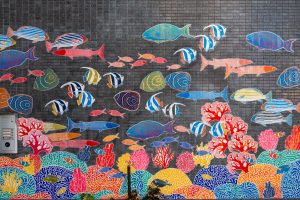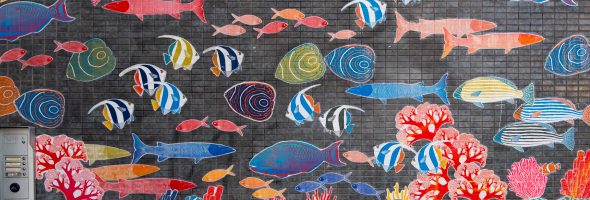Month long guided inquiry on…
“Mural Math”

Created by Lauren La Prairie & Laurel Apps
Introduction (2-3 mins):
This lesson is best implemented in a grade 7/8 math class, focusing on learning graphing, linear relationships and proportions. We want to cover how following an exact ratio of two or more proportions should amount to the same composition regardless of net quantities. We intend to demonstrate this using the example of mixing paint for projects both small and large. We want this lesson to highlight for our students exactly why proportion matters in the “real-world” and how having an intrinsic understanding of it will directly benefit the projects they pursue going forward.
Prior to grade 8, students will have built their understanding around equivalent linear relations by representing them symbolically, practicing substituting values into variables and finding equivalent fractions, all which were explored in depth in the grade 7 patterns and relations unit. The skills our proportion lesson requires from students include making relationships to patterns and like amounts and some fluency around XY graphing.
We anticipate this lesson would take 40 minutes and would be an introduction to a month long unit. Depending on the independence of the students, a group may work alongside the teacher, while others may opt to work alone or in pairs.
For this lesson, we would conduct formative assessments of students’ starting knowledge and would be using an elaborated checklist sheet for each student, based largely on their math journal reflection completed at the end of the lesson. See our appendix for our assessment sheet to gain an idea of what we would assess for specifically.
Objective: To enhance students’ proportional literacy and understanding of proportional reasoning in order to help them more accurately request their needs. Have students work with a small/manageable quantity (30 ml of paint) before working with larger, mural sized quantities.
First Peoples Principles of Learning:
- Learning ultimately supports the well-being of the self, the family, the community, the land, the spirits, and the ancestors.
Big Idea:
- Number represents, describes, and compares the quantities of ratios, rates, and percents
Curricular Competencies:
- Use reasoning and logic to explore, analyze, and apply mathematical ideas
- Estimate reasonably
- Use tools or technology to explore and create patterns and relationships, and test conjectures
- Model mathematics in contextualized experiences
Content
- numerical proportional reasoning (rates, ratio, proportions, and percent)
Key terms:
- Proportion ↭ Ratio ↭ Scaling ↭ Linear relationships ↭ XY coordinates ↭ Constant variable (eg. y=k(x) where k is the constant variable)
Materials for lesson:
- Number talk sheet
- Red, yellow, blue, and white paint
- Measuring spoons
- Paintbrushes
- Mixing plates
- Paper
- Graphs to plot colour lines on
- Manipulatives to count out ratios
- Criteria checklists for each student
Opportunities for differentiation/ personalized learning:
Differentiation- Students are given a choice between 3 reflection questions to answer. The questions are varying in level of difficulty to ensure all students are challenged while being able to successfully complete the questions themselves.
Personalized learning- Students are given autonomy over what parts of the mural they are completing (mixing large quantities of paint, shopping, painting, financial planning
- Student chosen inquiry project
- Students can work in groups or individually
Students with Individualized Education Plans (IEP)- if students are working to meet individual goals from an IEP, they should still participate in the creation of the mural and might calculate the amount of paint they are using to create their colour in a different manner. Rather than graphing out a line, they may write down the paint ratios on a piece of paper. Students could also create the paint colour with a group and other group members can help with the plotting of the line points on the graph.
Opportunities for cross-curricular content:

Lesson
Number talk (before beginning lesson) refreshing understanding of equivalent fractions
*see Appendix for Number Talk handout
Hook: 90s music video about mural math (1 minute)- made of students actions during previous art and math lessons
Question: “What is another word for proportions that you may have heard or used in math before?” (ratio, fraction, scale)
Lesson progression:
Here we present a guided inquiry study on integrating art, social justice and financial literacy into the math concept of proportion, which is best suited to the grade 7 curriculum. Through this month long inquiry, students are meant to explore proportions and linear relationships, all in the hopes of seeing how proportion is present in everyday life. When you consider food, art, seashells (golden ratio) and any number of topics you can begin to clue your class in to why proportion will matter to them for the rest of their lives.
As we discussed previously, our class decided to create a class mural celebrating pride, to be completed prior to the parade at the end of June. As such, this unit would be completed around May/June, and in that way is great for split classes who have grade 8s in need of a proportion refresher as well. Students have to work within a budget (more to come on that later in this unit!) and attend to a specific area. Due to our budget and the size of the mural, we are only able to purchase paint in 4L bottles. The only colours that come in these bottles are primary colours and white. Our activity today is to make an exact recipe that is scalable to our mural. You will be given two different colours and the total quantity of your mixture should be 10 ml.
For example, *teacher demonstrates mixing ratio in front of class* you may have 5 ml of yellow and 5 ml of red to make orange. Once students’ base ratios are complete, we will be plotting their proportions on provided graphs. Ask students to consider- “How much of each would you need if the mural required 7L of orange paint?” or “How many 4L bottles of each base colour (Ie. red and yellow) would you need to buy?” These are the types of questions that you should get your students to answer so they can take full ownership over the completion of this project. Start somewhere manageable- “Our next step is to find out how many ml of each colour you will need, if you were creating a L of the mixture.” (5 mins)
When they have dialed into their exact ratio, have them plot various quantities (up to 60ml) on class graphs to show the relationship between different quantities while keeping the ratio the same. Here we can talk about the formula y=kx and how that is relevant to scalable quantities, and the importance of accuracy on (x, y) graphs in clearly conveying needed information.
Wrap up
3 questions on board for them to attempt in their math journals at end of lesson (~10min):
(1 everyone can do, 1 most can do, 1 extending students can do)
- How many ml of both your mixing colours would you need for 1L total of your new paint colour?
- Find the constant variable (y=kx) for your pigment concoction and use that to find out which quantities you need if you have:
-5L of your X colour?
-17L of your Y colour?
-2.25L of your X colour?
- If a 4L tub of paint costs $22.75, what is the cost of your X colour and Y colour when you are making:
-1L total of paint?
-5L?
-600ml?
Adaptations:
- Small groups for teacher led instruction
Extensions:
- Financial component: calculate the cost of the supplies for the mural (create linear relationship between price of paint and quantity)
What to expect in future lessons:
- Further elaboration of financial factors, including pricing out supplies according to surface area of final mural, transportation costs of materials and recordings of exact usages for inventory
- Creative sessions on mural design, culminating in the final execution of said mural
- Enhanced practice with decimals, proportional reasoning and graphing
For assessment tools, consult this Proportional Reasoning.

